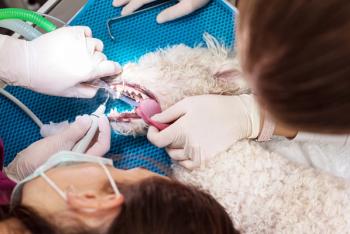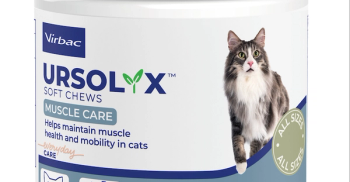
Working between the brain and the mind

Veterinary collaboration can help determine whether a case is a neurological or behavioral condition
This content is sponsored by Zomedica.
Determining whether a patient has a neurological or behavioral condition‑and which veterinary specialist to seek out with certain cases—can be a challenge. Using a series of video case studies, an interactive session at the 2022 Fetch dvm360® Conference in San Diego, California, showed attendees how to use body language to better ascertain if a mind disorder or brain disfunction is affecting a patient.
Christopher Pachel, DVM, DACVB, CABC, with Animal Behavior Clinic in Portland, Oregon; and Fred Wininger, VMD, MS, DACVIM (Neurology), with Charlotte Animal Referral and ER in Charlotte, North Carolina, collaborated to present the session. The pair have been assisting each other with patients for a couple of years, they noted. “We share cases back and forth via email and video from this standpoint [that] we’re both working within the brain,” Pachel said. “It’s not always clear whose skill set really needs to be leveraged for those individual cases.”
With patients presenting issues such as structural abnormalities, functional changes, and cognitive impairment, there is potential for overlapping veterinary specialties. In these cases, Pachel noted common questions: Who do you call? Where do you refer? Which textbook do you open? Which medications to you try first? And, when collaborating, is this case yours or mine?
Patient observations
Pachel and Wininger provided examples of patients filmed exhibiting various types of body language that serve as clues to whether their condition might be neurological or behavioral. With each case, the audience was asked their opinion about which specialty should address the patient’s condition and weigh in with their own observations.
The first video relied on an examination of a dog, for which the audience overwhelmingly expressed that its body language suggested a neurology case. Clues included a short-stride gait, an extended neck, and not communicating anxiety or stress. “OK, so he seems like he’s behaviorally normal,” said Wininger.
Although Wininger and Pachel both noted subtle potential signs that could indicate a behavioral condition, such as certain small movements, the speakers ultimately agreed with the audience’s assessment with the first case they presented.
Another video prompted the speakers to addressed paroxysm—events that begin and end “out of nowhere”—such as seizures, narcolepsy, and vestibular syndromes. “[Paroxysm] is not going to include most behavioral disorders. It’s going to include neurology but maybe some other things too,” said Wininger.
In the video, a dog appeared to turn his head, rather than tilt it, and freeze, possibly losing consciousness. “He seems kind of unaware. I’m already thinking of brain problems, seizure problems, because of the head turn and then he’s not paying attention,” said Wininger.
“It’s called an absence seizure,” he added. “Although they are hard for us to characterize in dogs, this is as close to an absence seizure as you can get.”
Subsequent videos indicated potential behavioral conditions. “We often talk about the behavior that we're observing and the antecedents or the relationship between that view, whether it's physical environment, or the social environment,” said Pachel. “Can I draw a connection here, and how the animal is interacting with what's happening around it?”
According to Pachel, observers can look for shifts or changes in posture. In one video case, a dog demonstrated hesitation in approaching a human visitor. The animal is stretched with rear legs anchored, and their head and neck reached out, to possibly smell or taste what’s in front of them, before recoiling back. “This is a dog who has stranger danger,” said Pachel.
In a second video with the same dog, the animal demonstrates more fear-based behavior. “We now have a level of hyper vigilance alertness,” said Pachel.
The dog holds a tight body posture and looks behind him. Pachel said this movement isn’t necessarily a response to something behind the dog, but rather an anticipation that something might be there. “That’s more characteristic of situation or generalized anxiety, or we see exaggerated startle responses, the readiness to respond if, and when, something changes in the environment,” he added.
In this case, the dog’s body language changes in response to the environment, along with the lack of physical changes or gait abnormalities, favors a more emotional condition rather than a neurological disorder, according to Pachel.
Other considerations
Wininger said that a decision on which type of specialist the animal belongs, as far as needs, should take into consideration the client’s needs as well. “Going to see a behaviorist is going to be very long examination. It’s going to be very interactive examination and probably a lot less expensive than seeing a neurologist, who is going to have a shorter examination and say, ‘these are the diagnostics that we need to run’. I think it's going to be a very different experience for your clients and so that's a big variable too,” Wininger added.
The availability of veterinary professionals may also be a deciding factor in which specialist to seek out for help. On the behavior side, Pachel said, it’s not uncommon to have 3 to 4 months lead time before a patient is seen. “And that’s unacceptable,” he said. “If you’ve got an acute issue, they need help.”
Reference
Pachel C, Wininger F. Brain or Mind: Where Veterinary Behavior and Neurology Collide. Presented at: Fetch dvm360® Conference; December 2-4, 2022: San Diego, CA.
Newsletter
From exam room tips to practice management insights, get trusted veterinary news delivered straight to your inbox—subscribe to dvm360.




